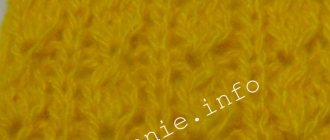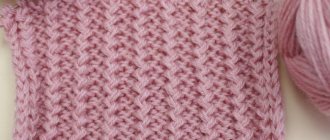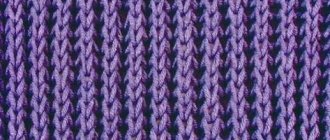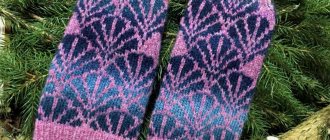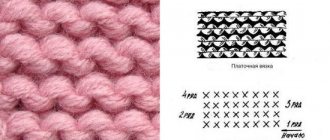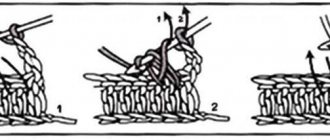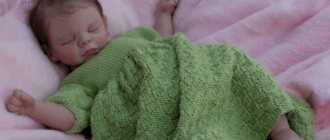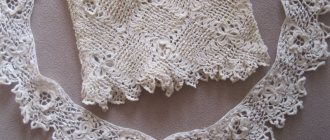A pattern such as rib is usually knitted along the edge of the garment, as well as at the bottom of the sleeves and neck of jumpers, sweaters or pullovers. Used for knitting cardigans, hats, scarves, snoods, socks, mittens.
It allows you to maintain the shape of knitted items, making them comfortable and warm. In some cases, the elastic band stretches and the product loses its appearance. To prevent this from happening, you must follow a few simple rules when knitting.
Varieties of knitted elastic bands
There are more than 30 different ways to knit elastic.
The following types are considered the most popular:
- Simple. Knitted by alternating knit and purl stitches through one (1x1) or several (2x2, 3x3 or more). In the purl rows, the loops are knitted according to the pattern. The canvas turns out identical on both sides.
- English or patent gum. The most popular type of pattern. It is formed similarly to a simple elastic band. A special feature of knitting is the yarn overs: they are made after each knit stitch, while the purl stitches are not knitted. Then the knit stitches must be knitted together with the yarn over from the previous row. With this knitting, the fabric is elastic and elastic, retains its shape well: due to the yarn overs, each loop is strengthened, making it double. The disadvantage of this method is the significant consumption of yarn.
- False . A lightweight version of the English gum, very similar in appearance. It differs in knitting technique, has a lower density, and stretches quickly. One of the advantages is low yarn consumption.
- Semi-patent . The front rows of this pattern are knitted like a patent rib with yarn overs. Purl - like a simple one, 1x1.
- Double or hollow elastic band . Knitted using a combination of knit, purl and slip stitches. With this knitting, you get 2 fabrics connected by the bottom and top rows. Elastic, retains its shape for a long time, ensures a tight fit to the body. This pattern is used to knit cuffs, shoulder collars, as well as hats and scarves. Yarn consumption is 2 times higher than usual.
- Polish gum . It is formed by a certain order of alternating knit and purl stitches. The fabric is of medium density, soft to the touch, with well-defined edges. Often used when knitting children's clothing - cuffs and collars knitted with Polish elastic do not put pressure on the baby's delicate skin, but retain heat well.
- Italian gum . Refers to decorative species. The voluminous effect is achieved with the help of thrown loops that are knitted through the row. It is used mainly for finishing when knitting cardigans, jumpers, and hats.
- French. Decorative elastic with figured edges, formed by throwing or moving a loop in each row. Used for knitting jumpers, sweaters, snoods.
- Canadian . Another type of decorative elastic band. It is knitted as follows: 2 rows alternate: 1 knit stitch and 2 purl stitches. In the next row, along with the front row, 1 more loop is pulled out from the previous row. It turns out to be a beautiful curly path. This knitting method can be used for any product.
Scheme and description of knitting a classic zigzag pattern
First of all, it’s worth understanding the knitting pattern of the most common variant - the classic one. The Zigzag knitting pattern consists of only 2 rows, which you must constantly repeat. In some descriptions the pattern is called a zigzag chevron.
The volume of pattern repeat can be completely different. It is knitted on 8, 10, 12, 14... 22 loops. For example, I give 2 diagrams: with 16 and 10 loops. When you compare them and knit at least one sample, you will be able to make any repeat yourself for a different number of loops.
Pattern Description:
Cast on number of stitches in multiples of 16 plus 1 stitch for symmetry plus 2 edge stitches.
1st row: chrome, *knit 1, yarn over, knit 6, knit 3 together, knit 6, yo* - repeat until the end of the row, finish knit 1, chrome. 2nd row: according to the pattern (knit yarn overs purl).
As you can see, knitting with a zigzag pattern on knitting needles is a fairly easy process. The only difficulty, in my opinion, is knitting the central strip. If you knit three stitches together in the usual way, the stitches in the center of the repeat will not look like a line. To make it work beautifully, you need the following: pick up 2 out of three loops with your right knitting needle from left to right (that is, first the second, then the first), then knit. the third stitch, and then throw the removed 2 stitches onto the third knitted stitch. Thus, the central loop will always be on top, forming an even strip.
How to do this, look at the photo:
How to knit with a zigzag pattern of 10 loops on knitting needles
For symbols, see the diagram above.
Drawing without holes
In the classic method for knitting with zigzag knitting needles, the fabric ends up with holes. For some models (for example, for skirts) this is not entirely acceptable. To prevent the product from being full of holes, a very small trick is needed. You need to knit the yarn overs with the wrong side crossed. To do this, from the outside, pick up the yarn over from left to right by the back wall and knit it purlwise.
Volume and simplicity
The first version of zigzag knitting was based on stockinette stitch. But it can also be done against the background of a scarf. The pattern scheme is almost no different from the classics. Let's take a zigzag on 14 loops for a change and look at how to knit a zigzag with a garter stitch. This is one of the Missoni style patterns.
If you want there to be no holes, then knit the yarn overs from the wrong side with the knits crossed.
Pattern diagram: The number of sts is a multiple of 14 plus 1 st of symmetry plus 2 edges. 1 r.: cr., *1 knits., nak., 5 knits., three knits together., 5 knits., nak.* - to the end of the r., 1 knits., cr. 2 rows: all knit stitches.
As you understand, the first row needs to be knitted according to the same principle as in the classical one. way. But the second r. For a garter stitch effect, knit with knit stitches. And in this case, it doesn’t matter at all how to perform the three central repeat loops together, because in the ribs there is a handkerchief stitch. the knitting will not be noticeably straight. Knit in a way that is comfortable and familiar.
Elastic band that doesn't stretch
A common problem when wearing knits is stretched hems and cuffs on the sleeves. Sometimes this can happen within 2-3 weeks. The item loses its appearance, becomes unsightly and uncomfortable.
How to knit an elastic band with knitting needles so that it does not stretch: 5 simple rules:
- To knit this pattern, you should use knitting needles 1-2 numbers smaller than for the main fabric. If the product is knitted, for example, on needles No. 4, then for elastic it is better to use No. 3 or 2.5. Then it will turn out dense and will hold its shape well.
- The choice of yarn plays a big role in maintaining the elasticity of the elastic. It is best to use mixed fibers: wool/acrylic, cotton/acrylic. Elastic bands made from natural yarns, especially cotton and cashmere, stretch very quickly. Products made from natural fibers with the addition of viscose and silk do not hold elastic well. Therefore, when knitting from 100% cashmere, linen or cotton, as well as from mixed yarn that contains silk or viscose, you should choose models without this type of finish. It is better to decorate the edge in a different way. When artificial fibers are added to yarn, it becomes more flexible and springy. This property is also transferred to the knitted product - the item retains its appearance longer and is less subject to wear.
- When knitting elastic, you can use additional threads that are attached to the main one. This is done to give the fabric additional elasticity and to prevent stretching. You can add spandex or elastic thread. It can be transparent or colored. The colored one is selected to match the tone of the main yarn. Some needlewomen knit an elastic thread into the cuffs of the finished product using a crochet hook.
- The knitting density should be medium: do not tighten the loops too much or knit too loosely. In the first case, the result will be an inelastic treatment. Wearing such a thing will not be comfortable. In the second, the appearance will quickly be lost, the edge will be stretched, the shape will be lost.
- Under no circumstances should the elastic be steamed or ironed. Heat treatment will hopelessly ruin the item. No amount of manipulation will help restore it. All that remains is to unravel and bandage.
On a sweater
When knitting a sweater, elastic can be at the bottom of the product, on the cuffs and collar. In this case, you should choose varieties with high density: double, English or simple. The entire product can be knitted with this universal pattern. In this case, different types of elastic bands are combined, decorative ones are used, as well as false ones to reduce yarn consumption.
It is important to know how to knit an elastic band with knitting needles so that it does not stretch when knitting a neckline, cuffs or the bottom of a shoulder item.
Tips for beginner knitters:
- You should choose a blended yarn: half-wool or half-cotton, with an acrylic or polyester content of 15% to 50%. If knitting from natural, add a thread of transparent spandex or elastic thread of the appropriate color.
- The thickness of the knitting needles should correspond to the thickness of the yarn. Usually the manufacturer indicates the recommended number on the package. To knit elastic, you should take knitting needles 1-2 mm thinner than for the entire product.
- Stick to medium density, do not tighten the loops, but do not loosen the knitting.
- If you plan that the cuff will tightly cover the wrist, then when moving to the main pattern you need to widen the fabric. To do this, yarn overs are made in the last row of the elastic, evenly across the entire width, according to preliminary calculations.
- When carrying out wet-heat treatment of a sweater, jumper or pullover, do not wring out the product by twisting it. You should carefully squeeze out excess water from it and hang it over a bathtub or basin to drain. If wet-heat treatment is carried out in a washing machine, you need to choose delicate modes of the detergent that correspond to the composition of the yarn.
- The water temperature for wool should not exceed 20°C, for cotton and wool blends – no more than 40°C. Knitted items can be pressed in an automatic machine at a speed of no more than 400 rpm. Otherwise, the item will “sit down” several sizes.
Socks
Knitting socks starts with an elastic band; usually a simple 1x1 pattern is used. The knitting needles are taken 1 mm thinner than those recommended by the yarn manufacturer, so that the fabric is denser and holds its shape. We should not forget about the composition of the yarn; additional thread can be added to natural fibers to add elasticity and wear resistance.
Products that are knitted loosely or when the loops are calculated incorrectly usually stretch.
You can knit a double hollow elastic band for the top of the socks, especially if they are knitted from thin yarn. This method of knitting will prevent stretching. Due to the high density of the fabric, the boot will not bunch up like an accordion. For socks, mittens and gloves, a knitting method such as an elastic band with a short loop removed can be used. Another name is one-and-a-half or pearl elastic.
It is knitted as follows:
- the first 2 rows like a simple 1x1.
- 3rd row : knit the purl loops as usual, and remove the knit stitches without knitting, while the thread remains behind the work.
- 4th row - knit with a simple elastic band.
- The 5th row is knitted in the same way as the 3rd.
- Starting from the 6th row , repeat the 3rd and 4th rows.
The result is a dense and elastic elastic band with very even, beautiful edges on the front side. The disadvantage of this method is that the pattern is not double-sided, it has a reverse side. But it holds its shape perfectly and does not stretch for years.
French gum
As for the symbols, here an empty cell indicates LP, and a cell with a circle stands for IP. The volume and corrugated relief of this elastic pattern is formed by alternating 2 LPs and 2 IPs, as well as by shifting the rapport in each next row. Due to the displacement, the ornament becomes extremely embossed. It should be noted that all loops of the pattern are knitted in the classical way. The number of loops cast on must be a multiple of 4P.+2 edge stitches:
- In the first row *2 LP and 2 IP*.
- In the second, rapport is performed *1 IP, 2 LP, 1 IP*.
- Starting from the third, the pattern is repeated from the very beginning, that is, from the first row.
Hats
How to knit an elastic band with knitting needles so that it does not stretch and cause discomfort on the hat is discussed below. When knitting hats, the most important thing is to accurately calculate the number of loops. It is necessary to knit the sample with the selected patterns, no less than 10x10 cm in size, and close the loops. Wash and dry it. After this you can do the calculation.
To more accurately calculate the required number of loops, it is important to measure the sample in a relaxed state and in a stretched state. When knitting, you should start from the width of the sample in a stretched form. Then the hat will tightly cover your head.
How to knit an English rib with knitting needles, diagram.
For the bottom of the hat, it is better to choose a double hollow elastic band, the structure and density of which is most suitable for knitting hats. The advantage is a two-layer fabric that is not blown through. This is especially true for children's things. When knitting a hat with a lapel, you can use other types of elastic bands: simple, English or semi-patent.
Due to the additional layer, heat will also be retained well.
When yarn with a high content of wool, angora, merino or cashmere (more than 50%) is chosen for knitting a headdress, you can knit the bottom with an elastic band with the short or one-and-a-half loop removed, which was mentioned above. Wool has increased thermal conductivity, and the pattern is dense enough to provide comfort.
On circular knitting needles in the round for beginners
Knitting in the round is used for various products. You can knit a sweater, pullover, jumper, dress, tunic or skirt in the round. Most hat patterns are knitted this way. Hayward - this type of jumper is knitted entirely in the round at the top, then the sleeves are worked separately, also on circular knitting needles.
This knitting method is very simple and convenient. Things come out without seams, do not require additional assembly, and fit beautifully on the figure. They are cozy and comfortable and retain their shape after many washes.
Knitting in the round is easy even for beginner needlewomen. All types of elastic bands require knit and purl rows, but they can easily be adapted for circular knitting needles. To do this, you need to knit the sample in rotating rows according to the pattern. It is important to understand the structure of the pattern, then it will be easy to repeat it in circular knitting.
Casting on loops on circular knitting needles is done in the same way as on straight knitting needles. Then you need to close the knitting. To do this, cast on 1 extra loop. When the set is completed, you need to remove the first 1st and pull it through the last one, tighten the thread - the ring is ready, you can start knitting the elastic according to the chosen pattern.
When knitting in the round, the main point is to maintain the same density so that the elastic looks nice and neat. The density needs to be monitored, especially for those who have just begun to master this type of needlework.
Generalized information about which types of elastic bands are more suitable for knitting different knitted products is presented in the table:
| Types of rubber bands | Sweater, jumper, pullover | Cardigan | Tunic, dress | Hats, scarves, snoods | Socks, mittens, cuffs |
| Simple | + | + | + | + | + |
| English | + | + | + | + | |
| False | + | + | + | ||
| Semi-patent | + | + | + | + | |
| Double (hollow) | + | + | + | + | + |
| Polish | + | + | + | ||
| Italian | + | + | + | ||
| French | + | + | + | ||
| Canadian | + | + | + | ||
| Elastic band with loop removed | + | + | + | + | + |
Even novice craftswomen can easily figure out how to use different types of elastic bands to decorate the edges of knitted items. To prevent them from stretching, it is necessary to choose the right knitting needle thickness, yarn composition, additional threads, and maintain an average knitting density.
We should not forget that knitted items cannot be steamed or ironed. Then a sweater, hat, jumper, pullover or socks will become your favorite item in your wardrobe and will retain its shape and appearance for a long time.
Video (how to knit elastic bands)
Canadian Gum
French gum
Scotch gum
Polish gum
Norwegian gum
Ethiopian gum
You might also be interested in:
- Nine tips for choosing yarn, answers to questions from beginners
- History of knitting
- Knitting - as a type of needlework, general concepts
- General information about loin knitting
- DIY headband with a bow
- The Scarlet Flower
- How to make a owl from felt
- Decoupage is the best way to make ordinary things beautiful
- about the author
- New master classes
Natalia
I'm VKontakte

